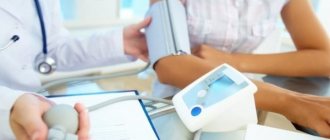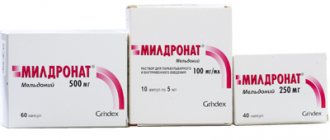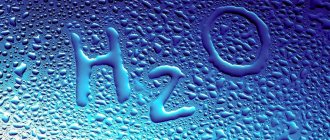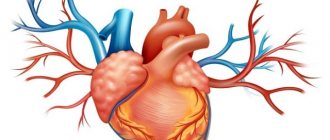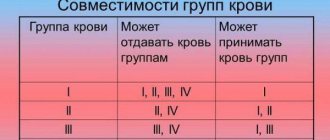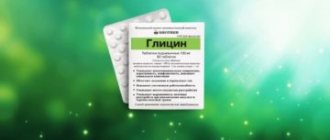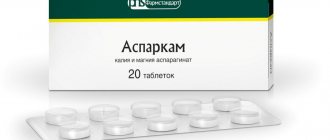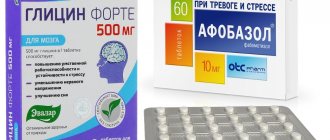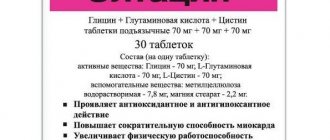For vegetative-vascular dystonia, doctors prescribe various drugs that can restore the functioning of the human nervous system. Here it is important to choose the right treatment method, since VSD is divided into different types with different symptoms. A remedy such as Glycine is prescribed to almost all people who suffer from this disease, since it is a universal sedative with a prolonged effect. To understand the real benefits and effectiveness of the drug, it is necessary to take a closer look at its features, properties, indications for use and possible side effects.
Glycine is used to treat vegetative-vascular dystonia
Classification of prescribed medications
If there is a disorder in the vegetative-vascular system of a mixed type, breathing exercises are recommended for treatment. Mixed disorder can be countered by focusing on deep and measured breathing. Mixed conditions require work on strengthening the nervous system. The best thing that is recommended for those suffering from mixed disorder is to brew herbal teas.
For dystonia of the hypertensive type, sedatives are used for treatment. Salt, caffeine, fats and alcohol are contraindicated for hypertensive dystonic patients. Hypertensive patients need physical activity, reflexology and water treatments. Vegetables and fruits, chocolate are recommended for hypertension.
Patients with hypotonic disorders will be relieved by ginseng and eleutherococcus. They are not prescribed to a hypotensive patient with increased excitability or insomnia. Baths and showers are recommended for a hypotonic state. Hypotonic dystonics need exercise therapy and reflexology.
For the treatment of VSD the following drugs are prescribed:
- Antidepressants are a group of psychotropic substances. Antidepressants improve mood, reduce or completely eliminate depression and apathy. Antidepressants relieve irritability and emotional stress. Antidepressants are taken for a course of at least six months. Antidepressants begin to act within 10-14 days from the start of treatment. Only a doctor will determine which antidepressant medications to prescribe;
- neuroleptics are psychotropic drugs;
- Tranquilizers are designed to relieve anxiety and relieve fear. Medicines are characterized by sedative, anticonvulsant, muscle relaxant and hypnotic effects;
- sedatives.
The mildest are sedatives, the strongest are antidepressants.
Nootropics are used to get rid of fears. They have a positive effect on the brain - normalize its functions and stimulate blood flow. Nootropics are Tenoten, Phenibut, Phezam, Phenotropil, Pantogam, etc. The metabolic group to which Glycine belongs also provides an anxiolytic effect.
Patients are also recommended other drugs that affect only the external manifestations of the disorder, without in any way affecting the root cause of their appearance. These include various new restorative drugs:
- mineral complexes containing magnesium, zinc and selenium;
- enzyme;
- beta-blockers (Mexidol, Anaprilin, Propranol);
- metabolic compounds (Actovegin, Riboxin);
- vitamins C and B,
- medications that normalize the functionality of the cardiovascular system;
- adaptogens are any compounds that increase resistance to negative external influences.
Phytotherapy
At the initial stage of the disease, VSD is treated with soothing herbs: valerian root, hawthorn, motherwort, peony tincture, oregano, lemon balm, thyme.
Medicines prepared from herbal preparations using an industrial method are also effective - Novopassit, Negrustin, Persen.
Vitamins and homeopathy
Vitamins are useful regardless of what type of disease (hypertensive, hypotonic or mixed) the disease has developed. The patient needs vitamins B and C. Vitamins A and E are also needed.
To achieve a general strengthening effect, not only vitamins are prescribed; in mild cases, homeopathy helps well. The course of treatment is drawn up on the basis of examination data, as well as what type - hypertensive, mixed or hypotonic - VSD
at the patient. The dosage is determined by the same principle.
Homeopathy is aimed at eliminating the causes of the disease. When selecting a course of treatment for adult patients, the possibility of adjusting the consequences of the condition is taken into account. Homeopathy has no side effects.
Just like vitamins, patients need other auxiliary substances. For tachycardia, a regimen that includes both vitamins and compounds containing potassium is more often prescribed. Homeopathists will also recommend Cardio-gran, Pumpan, Neurohel, etc. Vitamins will give you strength, but everything else is both a sedative, a vasodilator, and an antispasmodic. For intracranial hypertension, both vitamins and diuretics are prescribed.
Adaptol are tranquilizers. The medicine helps increase the level of serotonin in brain tissue. Adaptol directly affects the central nervous system without affecting its peripheral parts. Based on the effects of Adaptol, it resembles antidepressants.
Adaptol has a specific taste. Adaptol should be combined with caution with other medications that have a psychotropic and sedative effect, as well as with alcohol. This remedy enhances their effect. In case of overdose, Adaptol complicates bowel function and leads to a decrease in body temperature and blood pressure.
Adaptol is most effective in the initial stages of development of vegetative-vascular dystonia. Treatment with it at the time of exacerbation of the condition is ineffective. Adaptol is used on an ongoing basis to prevent attacks.
Actovegin contains minerals and fatty acids. Actovegin has a strong antioxidant effect. Actovegin helps eliminate metabolic and vascular abnormalities in the functioning of the brain.
For vegetative-vascular dystonia, Actovegin is prescribed intramuscularly. The prescribed release form, dosage and course duration are determined depending on the severity of the condition.
Actovegin can cause urticaria and fever. Actovegin can provoke anaphylactic shock. Actovegin does not affect attention.
Anaprilin - relieves angina attacks. Anaprilin also slows down the speed of transmission of nerve impulses to the myocardium. Anaprilin increases the tone of the uterus and bronchi. Anaprilin should not be prescribed for hypotonic VSD, asthma, depression, or heart failure. Anaprilin is also contraindicated in case of cardiac conduction disorders.
Anaprilin has proven itself well in the treatment of hypertensive type VSD. Anaprilin alleviates panic attacks. This is due to the fact that Anaprilin affects the sympathetic nervous system.
Afobazole is a selective anxiolytic. Afobazol is not endowed with muscle relaxant capabilities. In case of vegetative-vascular dystonia, Afobazole is necessary for the prevention and treatment of anxiety conditions. Afobazol gives effect after 3-4 weeks of use.
Afobazole does not interact with Thiopental or ethanol-containing compounds. Afobazole can enhance the anti-anxiety effect of Diazepam.
Tablets are prescribed to patients with unstable mental health and suspiciousness. Afobazole should not be taken by pregnant, lactating women, or children.
In case of overdose, Afobazole produces a pronounced sedative effect.
Grandaxin
Grandaxin is a muscle relaxant with an anticonvulsant effect. Grandaxin is a mild tranquilizer. Grandaxin relieves withdrawal symptoms, relieves insomnia and obsessive worries. Grandaxin is taken in a course, the result of its effects appears after some time.
Grandaxin goes well with hormone therapy. With a well-chosen therapeutic regimen, Grandaxin has no side effects. If the dosage is exceeded, muscle spasms and cramps are possible. Grandaxin can lead to depression of the respiratory center. Grandaxin is allergic.
Corvalol has a complex effect on the body. It is used to treat heart pathologies. Corvalol has a calming effect.
Mexidol facilitates mental activity and activates blood supply to the brain. Mexidol also has membrane protective and antioxidant capabilities. Mexidol is used to treat neuroses and anxiety disorders.
Mexidol is administered intramuscularly or intravenously. Mexidol should not be taken if the liver or kidneys are impaired. Mexidol is not prescribed to children either. Mexidol enhances the effects of anticonvulsants, antipakinsonics and anti-anxiety compounds of the benzodiazepine series.
Persen is a calming composition. Persen contains extracts:
Persen helps with headaches and dizziness. Persen is also indicated for cerebral vascular spasms. Persen helps normalize sleep. Persen enhances the effect of painkillers.
Piracetam has a wide spectrum of action. Piracetam enhances glycolytic processes and facilitates the utilization of glucose. Piracetam increases the integral activity of the brain and facilitates learning. Piracetam restores and stabilizes cerebral functions (consciousness, speech, memory). Piracetam accelerates microcirculation without constricting blood vessels.
Piracetam should not be prescribed for renal failure, acute stage of hemorrhagic stroke, agitated depression, Huntington's chorea.
Piracetam is contraindicated in children under 1 year of age, pregnant and nursing mothers.
Tenoten is a homeopathic medicine with a pronounced anti-anxiety effect with an activation effect. Tenoten activates mechanisms that can limit stress. Tenoten is neither a muscle relaxant nor a sedative. Tenoten is used to treat asthenia and neuroses with an anxiety component, as well as for vegetative-vascular dystonia.
Tenoten relieves tension, instability of the psycho-emotional state, and dizziness. During intoxication, as well as during hypoxia, Tenoten acts as a neuroprotector.
Tenoten is compatible with other medications.
Due to the fact that Phezam contains Cinnarizine, the drug stimulates blood circulation. Phezam also contains Piracetam.
Phezam is a nootropic. Fezam is also characterized by a vasodilating effect.
Phezam is prescribed for a variety of problems with the central nervous system. Phezam is used for prevention of headaches. Taking Phezam reduces the incidence of depression.
Phenibut is a nootropic. Phenibut is intended to relieve anxiety and tension. Phenibut reduces irritability. Phenibut relieves headaches.
Phenibut improves mental and physical performance. Phenibut is indicated for patients with asthenia.
Phenibut should not be prescribed if the patient has an ulcer or liver failure.
Phenazepam is a tranquilizer. The tablets have a relaxing effect on the muscles. Phenazepam relieves anxiety and levels emotional stress.
The tablets provide relief for reactive psychoses, psychopathic states, neuroses and vegetative-vascular dystonia. Phenazepam is needed for obsessive states. With VSD
Phenazepam is valuable as a means of influencing sympathoadrenal crises.
Phenazepam should not be taken during pregnancy or while breastfeeding. Phenazepam tablets are not prescribed to children. Phenazepam can have a negative effect in case of organic brain damage, renal and liver failure.
Release form: tablets or solution. Phenazepam should not be combined with ethanol-containing products.
Complications of taking the drug
Glycine is a drug that is well tolerated by the body. This is due to the fact that the amino acid in its composition is a natural substance for humans. It is quickly absorbed by tissues and causes virtually no side effects. The latter appear in extreme cases and are expressed in the form of drowsiness, weakness and low blood pressure.
The product has virtually no contraindications. It can be taken by adults and children, pregnant women and women during breastfeeding. But it is worth considering that Glycine neutralizes the effect of neuroleptic drugs, sleeping pills, anticonvulsants, and antidepressants.
The only obstacle to treatment with the drug is its individual intolerance. In patients with hypotension it should be used under blood pressure control.
Glycine can be purchased at a pharmacy without a prescription.
Cinnarizine
Cinnarizine is not an antidepressant or tranquilizer. This is a restorative. Cinnarizine is indicated to normalize the functioning of the vestibular apparatus. That is, Cinnarizine helps with motion sickness. Cinnarizine is also prescribed to children with developmental delays.
Cinnarizine is an auxiliary medication in the treatment regimen for vegetative-vascular dystonia. Cinnarizine normalizes blood circulation. Cinnarizine is prescribed exclusively by specialists.
Eltacin is a three-component composition. It contains Glycine, Cystine and Glutamic acid. By forming Eltacin, they contribute to the fact that the body independently begins to produce glutathione.
Each component included in Eltacin - Glycine, Cystine and Glutamic acid - works as a self-sufficient agent. Eltacin contains these components in optimal proportions. Eltacin also contains Glycine, which normalizes the functioning of the nervous system.
Eltacin adequately copes with autonomic dysfunction. Eltacin has one contraindication – hypersensitivity to its individual components. Eltacin is most often prescribed to adolescents.
Dosage regimens
The drug is available in tablets of 100 mg, 50 pieces in a blister. The dragees are white in color and taste sweet (it’s not for nothing that glycine is translated from Greek glykos as “sweet”).
It is important to know how to take these pills correctly. They are used sublingually, that is, placed under the tongue and dissolved. At the same time, do not drink water.
This method of taking the drug ensures its rapid absorption into the blood and into the brain. This reduces the amount of medication that passes through the liver. This is an important point in using the drug, because once glycine enters the liver, it can be transformed into another substance under the action of transaminase.
The standard regimen for taking Glycine is 1 tablet 2-3 times a day, but no more than 3 tablets per day. Its effect is cumulative, so it is taken for at least 1 week, in some cases 2 or 1 month.
Another feature of the drug is that it is also indicated for children. For children over 3 years old, Glycine is recommended in the same dosage as for adults. For children under 3 years of age, the dose is reduced by 2 times - 50 mg. But it is worth understanding that the decision about how much the drug should be taken and in what quantity is made by the doctor.
Efficacy of therapy
Drugs: effectiveness according to patient reviews on the Internet.
Vegetative-vascular dystonia is a very common problem in modern society; according to statistics, about 85% of people suffer from this disease. However, there has been no official recognition of VSD, which is why the symptoms of the disease are so vague that it is sometimes difficult to make a correct diagnosis and prescribe a therapeutic course of treatment. Due to its wide availability and harmlessness, a course of Glycine is prescribed for VSD.
It is not some kind of panacea or a universal remedy against any symptom, but due to its positive effect on the body during VSD, it is popular among people faced with this problem. Even if it does not bring the expected medicinal effect, it will not cause harm and will not lead to the development of any complications.
The effectiveness of Glycine for vegetative-vascular dystonia depends on the type of disease, duration of medication use and everything you need to know when using this drug.
Causes of the disease
A vegetative-vascular symptom is characterized as a certain state of the body, and not a disease, because such a diagnosis does not officially exist. It differs in localization, manifestation and severity of various factors influencing the body. Due to localization, some types of VSD are distinguished. Disturbances in the functioning of the respiratory system are called the respiratory type of VSD, the brain - cerebral VSD, and the digestive - gastroenterological, etc.
When the human body's abilities are so weak that they cannot adapt to changes in the environment, autonomic failure occurs. From birth, the resources of the nervous system are laid down, so this genetic factor shapes the body’s susceptibility to various situations. People with a stable nervous system, in whom all processes of inhibition and excitation are in balance and do not go beyond limits, find it easier to endure various stressful situations. Their central nervous system does not feel the negative consequences with the development of complications due to the disease. But for those whom nature has not endowed with a strong nervous system, they have to suffer even from frivolous experiences. In the process of fear and panic, the body weakens, its protective functions decrease, and the person is overcome by depression. Against this background, neurosis and disruptions in the functioning of the autonomic system may develop. Dystonia appears in vulnerable and sensitive people much more often. The likelihood of dystonia is especially high with neuroses and other mental disorders.
There are the following causes of the disease:
- blood pressure level is too low;
- life shock, stress;
- low mobility, sedentary lifestyle;
- hormonal changes in the body;
- poor sleep;
- hereditary predisposition;
- due to some diseases oxygen starvation.
Symptoms
Manifestations of VSD can be different and manifest themselves in different ways, but there are main signs of autonomic disorders:
- constant lack of strength, weakness and fatigue;
- excessive sweating;
- frequent mood changes;
- chills, numbness of extremities;
- cold feet and hands;
- anxiety and panic fear for no apparent reason;
- depressive states.
Stress seriously poisons life and leads to the development of VSD. According to scientists, people engaged in mental work, workaholics and careerists often suffer from malaise due to lack of sleep, lack of proper rest and inability to relax.
Efficiency
Glycine is an amino acid that regulates the metabolic process of nerve cells, autonomic functions of inhibition and excitation. Eliminating the symptoms of VSL, Glycine accumulates its effect throughout the entire course of treatment with the drug. This is not a one-time sedative. The drug has a prolonged effect and is used for a number of other diseases in the field of cardiology, psychotherapy and neuralgia.
Glycine does the following:
- prompt relief of nervous tension as a result of failures at work or life problems;
- controls the processes of autonomic function, reduces agitation in the body and normalizes inhibition;
- improves sleep;
- helps accelerate mental performance;
- eliminates the consequences of motor hyperactivity;
- protects the body from stress.
Features of application
The drug does not work with a single dose. It is necessary to undergo a full treatment course. The effectiveness of therapy will increase when using non-drug therapy: a balanced diet, moderate exercise, and the creation of a calm environment. The medicine is equally effective on all people, regardless of age and gender. Refers to drugs with minimal contraindications and side effects. Taking “Glycine” goes well with B vitamins: the state of the autonomic nervous system is normalized, neuroses and depression are eliminated.
Effect on the central nervous system
Patients with VSD have a fairly strong susceptibility to changes in atmospheric air pressure and sensitivity to any weather changes. As a result, they suffer from frequent, intense headaches, which affects the central nervous system and cardiovascular system. This is why headaches can be combined with heart pain or other cardiac disorders. In such cases, the doctor usually prescribes drug therapy that brings the patient’s mental state back to normal.
A complex of Glycine and Vitamin B makes the body more resistant to stress and depression. It helps protect the vascular system during menopause in women.
For neurological disorders, the drug is an indispensable remedy: it provides brain cells with oxygen and the necessary amount of glucose, eliminating increased intracranial pressure and relieving the body of unpleasant brain manifestations, removing the following symptoms:
- pale facial skin;
- disturbing feelings of fear and unreasonable anxiety;
- pain in the heart area.
In the initial stage, the following symptoms may appear:
- chronic fatigue;
- increased irritation, lack of mood;
- apathy towards everything that happens.
With the help of Glycine, you can significantly improve and facilitate the patient’s quality of life, making the functioning of the nervous system consistently effective.
When should you take the medicine?
Indications for use of glycine:
- frequent stressful conditions;
- autonomic disorders (heart pain, blood pressure instability, abdominal pain, sweating, rapid heartbeat, dizziness, headache);
- intense psycho-emotional stress, for example, during exams in children;
- deterioration of mental performance, fatigue, inattention;
- behavioral disorders in children - moodiness, excessive activity, aggression;
- alcoholism;
- neuroses, neurasthenia, depression, reduced emotional background;
- organic brain diseases - trauma, encephalopathy, consequences of ischemic stroke, epilepsy.
Treatment during pregnancy
Since during pregnancy, receptivity to the outside world and sensitivity to any changes moves to a new level, a pregnant woman may experience emotional stress. The restructuring of the hormonal system produces unexpected behavior and emotions.
Glycine can be used only if no effect has been observed from other drugs. You definitely can’t take Glycine before the second trimester of pregnancy.
However, in the second trimester, the need for such medications disappears by itself, because a woman’s hormones return to normal during this period, and attacks of dystonia rarely occur. And a couple of months before giving birth, the pregnant woman is overcome by fears, she becomes irritable and nervous, her mood changes all the time, the woman sleeps poorly, she is tormented by nightmares associated with the upcoming birth and the birth of the baby. During this period, you need to resume taking the drug and help the body's nervous system.
It will take several weeks to feel the effect of taking Glycine. It is better to combine its use with herbal remedies, motherwort infusion, and soothing teas. Women with low blood pressure should not take it, so as not to cause fainting. In any case, you need to consult a doctor who will tell you about all the benefits and warn against possible consequences.
Contraindications
The drug is not recommended for children
The drug is safe and has no absolute contraindications other than individual intolerance. Glycine should not be given to children under three years of age, nor should it be taken by patients with arterial hypotension. When the pressure is below 100/60 mmHg. You should refrain from taking pills.
But for hypertension, Glycine can be considered as part of a complex therapy for vascular disorders.
Interaction with alcohol
No drug tolerates proximity to alcohol, Glycine is no exception in this regard. Alcohol can excite the central nervous system or relax it. In vegetative-vascular dystonia, such compatibility contributes to more pronounced symptoms of the disease. The condition may worsen in one direction or the other. Those. if alcohol excites the body, a person will feel increased irritability and emotional instability. But there may be another option - a hysterical state, anger, depression, accompanied by tearfulness, resentment and uncontrolled emotions.
The actions of Glycine will be suppressed under the influence of alcohol, so you need to decide what is more important to you: an addiction or relief from symptoms of VSD .
"Glycine" and alcoholic drinks
Alcohol is a specific product that has an irritating effect on the central nervous system, so most medications are not recommended to be taken with it. “Glycine” is no exception; taking it together affects the patient’s body in the most unpredictable way. On the one hand, it can aggravate the symptoms of VSD, and the person will become emotionally unstable, and on the other hand, on the contrary, it can cause despondency, increased tearfulness and apathy. And at the same time, instead of therapy, you can get an even more advanced disease that requires long-term treatment.
Complex therapy
One drug is not able to cover the entire range of necessary measures, so Glycine is often used in combination with other drugs to enhance the therapeutic effect. For unpleasant sensations in the heart area, the following sedatives are prescribed: Persen, Fitosed, Corvalol, etc.
To improve mental abilities and memory, nootropic medications may be prescribed: Cinnarizine or Vinpocetine.
To ease nervous tension, Glycine is combined with homeopathic remedies. You can also combine it with vitamin and mineral complexes, but you need to choose only biologically active substances that have antioxidant properties.
The effectiveness statistics of the drug are quite high; the drug helps to cope with imaginary anxiety during VSD. After completing a course of aminoacetic acid, attacks of discomfort may not disappear altogether, but patients note a decrease in their negative manifestations, especially in the evening.
It is important to understand that Glycine alone cannot cope with problems of impaired autonomic functions. It is necessary to completely reconsider your views on your lifestyle and daily routine. Start doing morning exercises, go in for sports, start eating regularly and properly. If possible, avoid stress and situations that are unpleasant for you, try to control your emotions and get less upset over trifles.
VSD
impossible to cure, because this problem does not even have official confirmation. You can simply avoid some consequences and complications in order to improve your quality of life and psycho-emotional background. Following simple rules will help reduce symptoms to a minimum.
